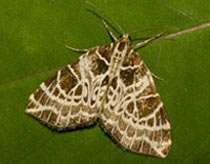Boosting the numbers of rare moth

(PhysOrg.com) -- The University of Reading has collaborated with the National Trust on research which has resulted in one of the rarest moths in the UK returning to Derwentwater in the Lake District, nine years after vanishing.
The netted carpet moth (Eustroma reticulatum) was last recorded at the Lake District National Trust site in 1999 and is listed as a species of great concern on the UK Biodiversity Action Plan (BAP).
This strikingly patterned moth was first recorded in the UK in 1856 at woodland near Windermere in Cumbria. Since then it has been found at only a handful of sites in the Lake District and north Wales. In the 1980s there was widespread concern about a severe decline in numbers, which led to its listing as a national priority on the BAP list.
The conservation challenge with the netted carpet moth relates to its total dependence on a scarce plant; touch-me-not balsam. Without sufficient balsam the future of the moth would be in serious doubt. The research, funded by Natural England, has found that the balsam does not form a long-lived seed bank in the soil and will disappear from a site within two years if unable to set seed.
Traditional hardy cows have played a crucial role in creating the right environment for the balsam to flourish. The cattle have reduced competition from perennial plants by grazing and trampling, creating more open ground which encourages the annual germination of balsam seeds. Balsam seeds have also been transported by the cattle's hooves, helping to creating new colonies.
Dr Paul Hatcher, Senior Lecturer in Applied Ecology at the University of Reading, who has been involved in the conservation of the netted carpet moth since 1990 explained: "In the mid 1990s we happened across a wood in the Lake District which was still being cattle grazed and contained an enormous population of Balsam and a significant netted carpet population. It appeared the cattle were encouraging the plant by poaching the ground and inhibiting the other ground vegetation. A little while later we were able to recreate this grazing regime in some National Trust-owned woodland near Coniston Water in Cumbria. Within a couple of years this led to a many-fold increase in the numbers of foodplants and caterpillars at these sites."
It has been such a success that, in the seven years since the initiative began the number of netted carpet larvae at the site in Coniston has risen from twelve, found on 400 balsam plants, to over 1,000 found on 56,000 plants.
Success in managing the habitat and boosting moth numbers at Coniston has enabled a reintroduction project at Derwentwater to take place. In autumn 2007 work was carried out to try and re-establish the moth at a traditional site near Derwentwater. Survey work carried out this autumn found a small number of Netted Carpet larvae, meaning that the re-introduced moths had successfully survived and bred.
Further larval translocations took place in 2008 to bolster the small population and hopefully lead to its permanent re-establishment at Derwentwater.
Source: University of Reading
















